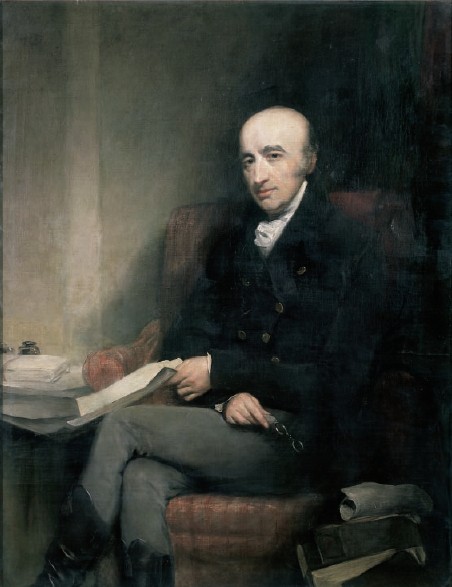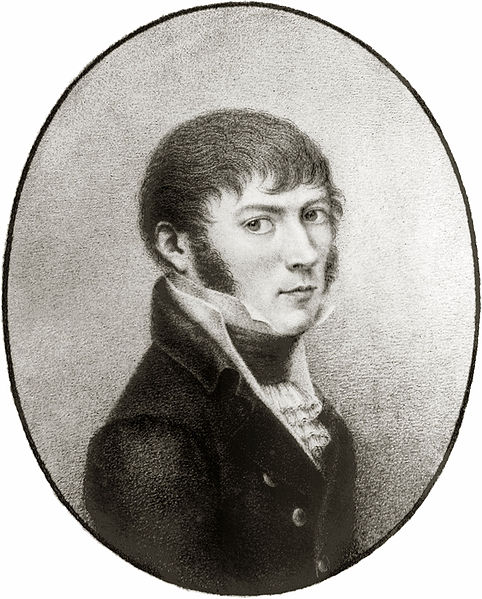<Back to Index>
- Chemist and Physicist William Hyde Wollaston, 1766
- Optician Joseph Fraunhofer, 1787
PAGE SPONSOR

William Hyde Wollaston FRS (6 August 1766 – 22 December 1828) was an English chemist and physicist who is famous for discovering two chemical elements and for developing a way to process platinum ore.
Wollaston was born in East Dereham, Norfolk, the son of the priest - astronomer Francis Wollaston (1737 – 1815) and his wife Althea Hyde. He was educated at Gonville and Caius College, Cambridge: in 1793 William obtained a doctorate in medicine from Cambridge University and was a fellow of his college from 1787 to 1828. During his studies he became interested in chemistry, crystallography, metallurgy and physics. The mineral wollastonite is named after him. In 1800 he left medicine and concentrated on pursuing these interests instead of his trained vocation. He was elected a Fellow of the Royal Society in 1793.
Wollaston died in London in 1828 and was buried in
Chislehurst, England.
Wollaston became wealthy by developing the first physico - chemical method for processing platinum ore in practical quantities, and in the process of testing the device he discovered the elements palladium (symbol Pd) in 1803 and rhodium (symbol Rh) in 1803.
Anders Gustav Ekeberg discovered tantalum in 1802, however, William Hyde Wollaston declared it was identical with niobium (then known as columbium). Due to Wollaston's influence the existence of columbium was temporarily denied. Later Heinrich Rose proved in 1846 that columbium and tantalum were indeed different elements and he renamed columbium "niobium".
Wollaston also performed important work in electricity. In 1801, he performed an experiment showing that the electricity from friction was identical to that produced by voltaic piles. During the last years of his life he performed electrical experiments that would pave the way to the eventual design of the electric motor. Controversy erupted when Michael Faraday constructed the first working electric motor and hastily published his results without acknowledging Wollaston's previous work. Wollaston, however, saw nothing wrong with Faraday's action. Wollaston also invented a battery that allowed the zinc plates in the battery to be raised out of the acid, so that the zinc wouldn't be dissolved as quickly as it would if it were in the battery all the time.
His optical work was important as well, where he is remembered for his observations of dark Fraunhofer lines in the solar spectrum (1802) which eventually led to the discovery of the elements in the Sun. He invented the camera lucida (1807), the reflecting goniometer (1809), and the Wollaston prism. He also developed the first lens specifically for camera lens called Wollaston's meniscus lens, or just meniscus lens, in 1812. The lens was designed to improve the image projected by the camera obscura. By changing the shape of the lens, Wollaston was able to project a flatter image, eliminating much of the distortion that was a problem with many of that day's biconvex lenses.
Wollaston used his Bakerian lecture in 1805, On the Force of Percussion, to defend Gottfried Leibniz's principle of vis viva, an early formulation of the conservation of energy. Wollaston was too ill to deliver his final Bakerian in 1828 and dictated it to Henry Warburton who read it on 20 November.
Wollaston's attempt to demonstrate the presence of glucose in the blood serum of diabetics was unsuccessful due to the limited means of detection available to him. His 1811 paper "On the non - existence of sugar in the blood of persons labouring under diabetes mellitus" concluded that sugar must travel via lymphatic channels from the stomach directly to the kidneys, without entering the bloodstream. Wollaston supported this theory by referring to the thesis of a young medical student at Edinburgh, Charles Darwin (1758 - 1778), "Experiments establishing a criterion between mucaginous and purulent matter. And an account of the retrograde motions of the absorbent vessels of animal bodies in some diseases." This Charles Darwin was the eldest son of Erasmus Darwin and not his more famous nephew, Charles Robert Darwin.
Wollaston also served on a royal
commission that opposed adoption of the metric
system (1819), and one that created the imperial gallon.

Joseph Fraunhofer, ennobled in 1824 as Ritter von Fraunhofer (6 March 1787 – 7 June 1826) was a German optician. He is known for the discovery of the dark absorption lines known as Fraunhofer lines in the Sun's spectrum, and for making excellent optical glass and achromatic telescope objectives.
Fraunhofer was born in Straubing, Bavaria. He became an orphan at the age of 11, and he started working as an apprentice to a harsh glassmaker named Philipp Anton Weichelsberger. In 1801, the workshop in which he was working collapsed and he was buried in the rubble. The rescue operation was led by Maximilian IV Joseph, Prince Elector of Bavaria (the future Maximilian I Joseph). The prince entered Fraunhofer's life, providing him with books and forcing his employer to allow the young Fraunhofer time to study.
Joseph Utzschneider was also at the site of the disaster, a fact which turned out to be important. With the money given to him by the Prince upon his rescue and the support he received from Utzschneider, Fraunhofer was able to continue his education alongside his practical training. In 1806 Utzscheider and Georg von Reichenbach then brought Fraunhofer into their Institute at Benediktbeuern, a secularized Benedictine monastery devoted to glass making. There he discovered how to make the world's finest optical glass and invented incredibly precise methods for measuring dispersion.
It was at the Institute that Fraunhofer met Pierre Louis Guinand, a Swiss glass technician, who Utzschneider had introduce Fraunhofer to the secrets of glass making. In 1809 the mechanical part of the Optical Institute was chiefly under Fraunhofer's direction, and that same year he became one of the members of the firm. In 1814, Guinand left the firm, as did Reichenbach, and Fraunhofer became a partner in the firm, the name being changed to Utzschneider und Fraunhofer. In 1818, he became the director of the Optical Institute. Due to the fine optical instruments he had developed, Bavaria overtook England as the center of the optics industry. Even the likes of Michael Faraday were unable to produce glass that could rival Fraunhofer's.
His illustrious career eventually earned him an honorary
doctorate from the University
of Erlangen in 1822. In 1824, he was awarded the
Merit Order of the Bavarian Crown, and made an honorary
citizen of Munich. Like many glassmakers
of his era who were poisoned by heavy
metal vapors, Fraunhofer died young, in 1826 at
the age of 39. His most valuable glassmaking recipes are
thought to have gone to the grave with him.
One of the most difficult operations of practical optics was to polish the spherical surfaces of large object glasses accurately. Fraunhofer invented a machine which obviated this difficulty, and rendered the surface more accurate than it was left by the grinding. He invented also other grinding and polishing machines, and introduced many improvements into the manufacture of the different kinds of glass used for optical instruments, and which he found to be always injured by flaws and irregularities of various sorts.
In 1811 he constructed a new kind of furnace, and on the second occasion when he melted a large quantity found that he could produce flint glass, which, taken from the bottom of a vessel containing two hundredweight of glass, had the same refractive power as glass taken from the surface. He found that the English crown glass and the German table glass both contained defects occasioning irregular refraction. In the thicker and larger glasses, there would be more of such defects, so that in larger telescopes this kind of glass would not be fit for object glasses. Fraunhofer therefore made his own crown glass.
The cause which had hitherto prevented the accurate
determination of the power of a given medium to refract
the rays of light and separate the different colors which
they contain was chiefly the circumstance that the colors
of the spectrum have no precise limits, and that the
transition from one to another is gradual and not
immediate; hence, the angle of refraction could not be
accurately measured. To obviate this, Fraunhofer made a
series of experiments for the purpose of producing homogeneous light
artificially, and unable to effect his object in a direct
way, he did so by means of lamps and prisms.
Thus in 1814, Fraunhofer invented the spectroscope. In the course of his experiments he discovered that bright fixed line which appears in the orange color of the spectrum when it is produced by the light of fire. This line enabled him afterward to determine the absolute power of refraction in different substances. Experiments to ascertain whether the solar spectrum contained the same bright line in the orange as that produced by the light of fire led him to the discovery of the 574 dark fixed lines in the solar spectrum.
These dark fixed lines were later shown to be atomic absorption lines, as explained by Kirchhoff and Bunsen in 1859. These lines are still called Fraunhofer lines in his honor - although they had previously been noted by Wollaston in 1802.
Fraunhofer also developed a diffraction grating in 1821, which occurred after James Gregory discovered the principles of diffraction grating and after American astronomer David Rittenhouse invented the first man made diffraction grating in 1785. Fraunhofer found out that the spectra of Sirius and other first - magnitude stars differed from each other and from the sun, thus founding stellar spectroscopy.
Ultimately, however, his primary passion was still practical optics, once noting that "In all my experiments I could, owing to lack of time, pay attention to only those matter which appeared to have a bearing upon practical optics". In the early 1990s, a firm that designed and built refracting telescopes was named in his honor, Fraunhofer Systems Company, since the telescopes were based on his design but now the company is part of Burbank Optical Company.
Fraunhofer produced various optical instruments including microscopes for his firm. This included the Fraunhofer Dorpat Refractor used by Struve (delivered 1824), and the Bessel Heliometer (delivered posthumously), which were both used to collect data for stellar parallax. The firm's successor, Merz und Mahler, made a telescope for the New Berlin Observatory, which confirmed the existence of the major planet Neptune. Possibly the last telescope objective made by Fraunhofer was supplied for a transit telescope at the City Observatory, Edinburgh, the telescope itself being completed by Repsold of Hamburg after Fraunhofer's death.